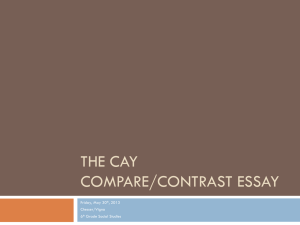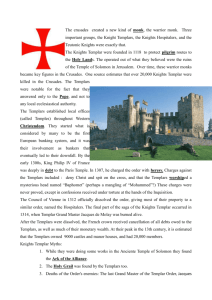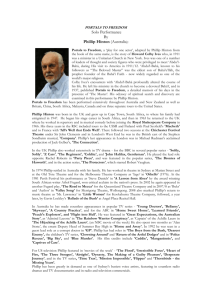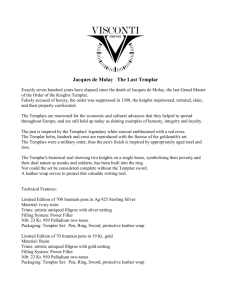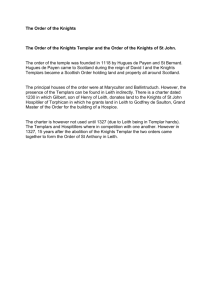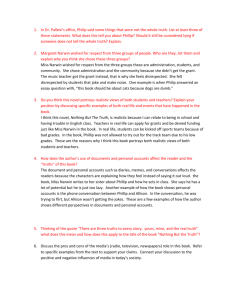King Phillip IV, Pope Clement V, and the Fall of the Knights
advertisement
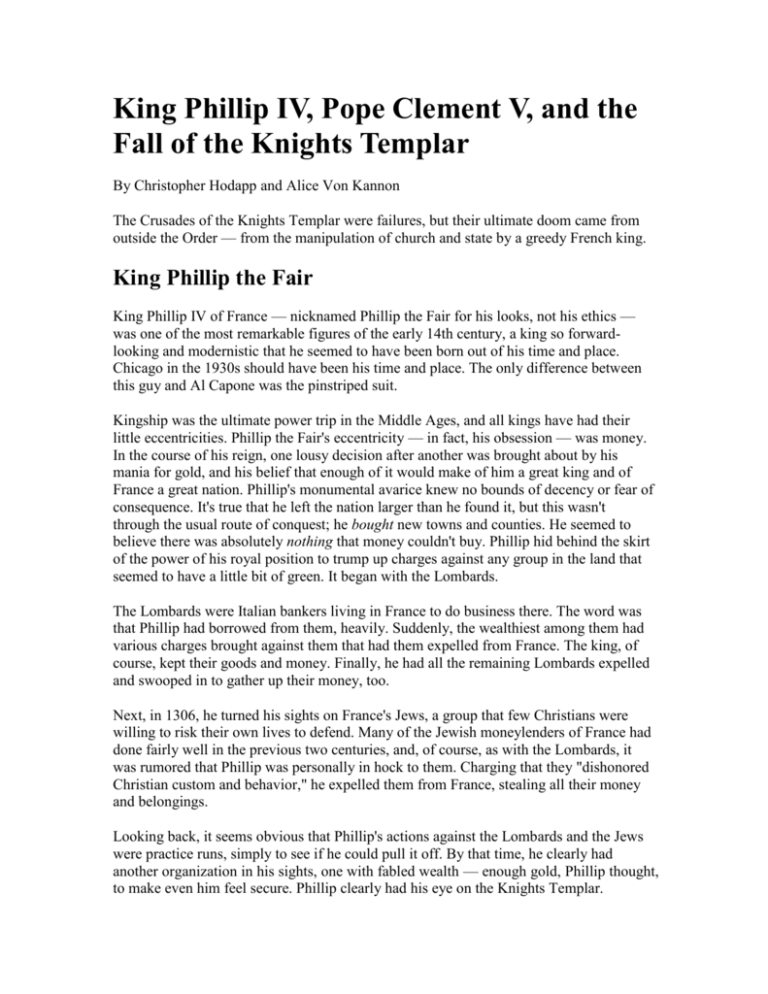
King Phillip IV, Pope Clement V, and the Fall of the Knights Templar By Christopher Hodapp and Alice Von Kannon The Crusades of the Knights Templar were failures, but their ultimate doom came from outside the Order — from the manipulation of church and state by a greedy French king. King Phillip the Fair King Phillip IV of France — nicknamed Phillip the Fair for his looks, not his ethics — was one of the most remarkable figures of the early 14th century, a king so forwardlooking and modernistic that he seemed to have been born out of his time and place. Chicago in the 1930s should have been his time and place. The only difference between this guy and Al Capone was the pinstriped suit. Kingship was the ultimate power trip in the Middle Ages, and all kings have had their little eccentricities. Phillip the Fair's eccentricity — in fact, his obsession — was money. In the course of his reign, one lousy decision after another was brought about by his mania for gold, and his belief that enough of it would make of him a great king and of France a great nation. Phillip's monumental avarice knew no bounds of decency or fear of consequence. It's true that he left the nation larger than he found it, but this wasn't through the usual route of conquest; he bought new towns and counties. He seemed to believe there was absolutely nothing that money couldn't buy. Phillip hid behind the skirt of the power of his royal position to trump up charges against any group in the land that seemed to have a little bit of green. It began with the Lombards. The Lombards were Italian bankers living in France to do business there. The word was that Phillip had borrowed from them, heavily. Suddenly, the wealthiest among them had various charges brought against them that had them expelled from France. The king, of course, kept their goods and money. Finally, he had all the remaining Lombards expelled and swooped in to gather up their money, too. Next, in 1306, he turned his sights on France's Jews, a group that few Christians were willing to risk their own lives to defend. Many of the Jewish moneylenders of France had done fairly well in the previous two centuries, and, of course, as with the Lombards, it was rumored that Phillip was personally in hock to them. Charging that they "dishonored Christian custom and behavior," he expelled them from France, stealing all their money and belongings. Looking back, it seems obvious that Phillip's actions against the Lombards and the Jews were practice runs, simply to see if he could pull it off. By that time, he clearly had another organization in his sights, one with fabled wealth — enough gold, Phillip thought, to make even him feel secure. Phillip clearly had his eye on the Knights Templar. Pope Clement V Unfortunately for the Knights Templar, at the beginning of the 14th century, a papal disaster was brewing, a political and religious mess that no one could ever have foreseen. It would be the final blow, the one from which they would not recover. Catholics often refer to it as the Babylonian Captivity. Nowadays, it's usually called the Avignon Papacy or the Great Schism. Either way, an atom bomb by any other name still blows everything to bits. King Phillip IV of France and his personal henchman Guillaume de Nogaret had been in severe conflict with the then-reigning pope, Boniface VIII. The pope had declared that the king of France had no right to tax Church property, and the money-hungry king Phillip had, obviously, disagreed. De Nogaret kidnapped an important French bishop, and the pope had come out swinging over it. He issued a papal bull proclaiming that kings must be subordinate to the Church, and that popes held ultimate authority over both spiritual and temporal matters on earth. To make sure they got the message, Boniface excommunicated Phillip and de Nogaret. Phillip answered his challenge by sending the brutal, devious, and bad-tempered de Nogaret at the head of an army to meet up with Italian allies and capture the pope. Boniface was, indeed, kidnapped and held for three days. After being beaten to a pulp, he was released; a month later, he died. The French king had proved just who was subordinate to whom, and he didn't mind a little papal blood on his hands. Pope Boniface's successor, Pope Benedict XI, lasted only a year in office — poisoned, it was said, by de Nogaret. But there were diplomatic difficulties to suffer for killing two popes. Consequently, King Phillip decided it would be easier to just buy one. He began procuring cardinals, pulling strings behind the scenes until the number of French cardinals in the Vatican's College of Cardinals was equal to the Italian ones. They then obligingly elected his handpicked candidate, Bertrand de Goth, making him Pope Clement V. The city of Rome was in turmoil, and the safety of the Vatican was in question. So, it didn't take much to convince the new French pope that his life would be in serious danger by living there. Clement obliged by staying in France, having his ceremony of investiture in Lyons. In 1309, he moved the Holy See to the city of Avignon (which was actually owned by the king of Sicily), right on Phillip's back doorstep. Clement had everything Phillip wanted in a pope: He was puny, weak, new in the job, and owed everything to his French king. Now was the time for the boldest move of Phillip's reign — the arrest of the Knights Templar. King Phillip IV of France set his sights on the fabled riches of the Knights Templar. His aim was to destroy the Templar Order and confiscate all their treasuries and properties in France, but he had to achieve it legally. The one surefire way was to accuse them of crimes so heinous that, if proved, no one would dare come to their rescue. It was no good to simply accuse the Grand Master or a handful of leaders. It had to be all of them, and he had to find a way to make the charges stick. And he had to be quick about it, because battle-hardened Templar knights were already returning to France, partly because of tensions on Cyprus between the Templars and the island's king. Phillip needed no more knights to cope with. King Phillip's audacious plan was to arrest every Templar in France, charge them with heresy, and exact immediate confessions from them by torture before Pope Clement V or anyone else could protest on their behalf. By making the charges religious in nature, Phillip would be seen not as an avaricious thief, but as a noble servant of God. Jacques de Molay, Grand Master of the Knights Templar, had been called to Poitiers, France, for the purpose of discussing with the new pope a new crusade to retake the Holy Land. For almost two years, he shuttled back and forth between the pope and King Phillip, essentially stamping out various diplomatic fires, such as the proposal to merge all the military orders. In June 1307, de Molay rode into Paris at the head of a column of his knights, with a dozen horses laden with gold and silver, to begin the financing of the new Crusade. For the next several months, Phillip treated the aging Grand Master with interest and diplomacy, and de Molay believed he and the Order were at a new turning point. He didn't know how right he was. October 1307: An unlucky Friday the 13th The end began at dawn on Friday, October 13, 1307. The sealed order to Phillip's bailiffs had gone out a full month before. It was accompanied by a personal letter from the king, filled with lofty prose about how heart-rending it was to be compelled to do his duty, while detailing frightening accusations against the Templars. The letter would have had an eye-popping effect on the king's men, and their secrecy was undoubtedly assured. The sealed arrest order was not to be opened until the appointed day. At this time, France was the most populous nation of Europe, even including Russia. And it was no tiny country either; France took up more than 40,000 square miles, an enormous area to cover from the back of a horse. Yet Phillip IV managed to carry off a stunning piece of work. Hundreds of the king's men simultaneously opened letters all over the country ordering them to converge on every Templar castle, commandery, preceptory, farm, vineyard, or mill. It was shockingly effective, instantly chopping off the head of the Order. Phillip obviously had a hit list of the most important knights to nab. Accounts differ wildly, but the most respected ones agree that 625 members of the Order were arrested in the first wave. These included the Grand Master; the Visitor-General; the Preceptors of Normandy, Cyprus, and Aquitaine; and the Templars' Royal Treasurer. The arrested Templars, whose average age was 41, were put into isolation and immediately subjected to the gruesome tactics of medieval "interrogation" on the very first day of their arrest. The technique of the strapaddo was common. It involved binding the victim's wrists behind his back, passing the rope over a high beam, pulling him off of the ground, and suddenly dropping him, snapping his arms and dislocating his shoulders. Stretching the victim on the rack was another favored method. Perhaps the most horrible was coating the victim's feet in lard or oil, and then slowly roasting them over a flame. Subjected to these agonies, the overwhelming majority of the knights confessed to every charge that was put to them. The confessions Phillip's goal was to arrest all the Templars, subject them to torture immediately, and exact confessions from them on the very first day. He knew that the pope would be livid over his actions, and that Church officials would be wary of agreeing to the kinds of interrogations Phillip had in mind, so time was of the essence. He wanted to hand Clement V a stack of confessions so damning that the pope would lose his stomach for siding with the Order. The pope reacted just as Phillip had planned. His outrage over the arrests turned to dread and resignation as the "evidence" was presented to him. Phillip leaned on Clement to issue papal arrest warrants all across Europe, which were largely ignored or skirted by other monarchs. Very few show trials went on outside of France, and there were no cases (outside of the tortured knights in France) of Templars who admitted to the charges of heresy. In an outburst of courage and remorse, most of the arrested Templars subsequently recanted their confessions and proclaimed to Church officials that their statements were made under the pain of torture and threat of death. To intimidate the remaining Templars, Phillip ordered 54 of the knights to be burned at the stake in 1310, for the sin of recanting their confessions. In 1312, Clement finally decided to end the situation at a council in Vienna. Just to make certain the decision went the way he intended, Phillip stationed his army on the outskirts of the city. The pliant pope officially dissolved the Order, without formally condemning it. All Templar possessions apart from the cash were handed over to the Knights Hospitaller, and many Templars who freely confessed were set free and assigned to other Orders. Those who did not confess were sent to the stake. Phillip, ever the cheap gangster, soothed his loss of the Templars' tangible assets by strong-arming a yearly fee from the Hospitallers to defray his costs of prosecuting the Templars.
